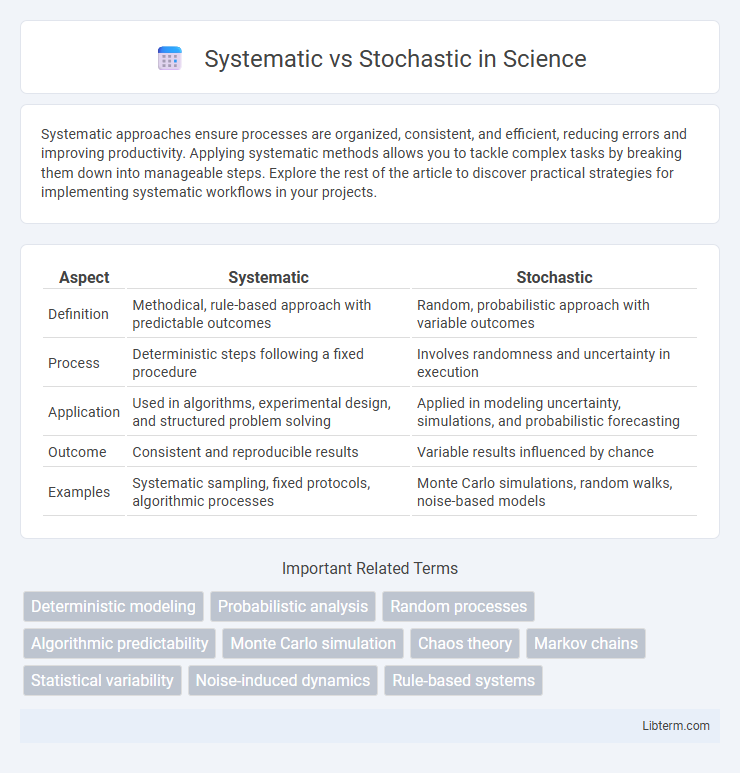Systematic approaches ensure processes are organized, consistent, and efficient, reducing errors and improving productivity. Applying systematic methods allows you to tackle complex tasks by breaking them down into manageable steps. Explore the rest of the article to discover practical strategies for implementing systematic workflows in your projects.
Table of Comparison
| Aspect | Systematic | Stochastic |
|---|---|---|
| Definition | Methodical, rule-based approach with predictable outcomes | Random, probabilistic approach with variable outcomes |
| Process | Deterministic steps following a fixed procedure | Involves randomness and uncertainty in execution |
| Application | Used in algorithms, experimental design, and structured problem solving | Applied in modeling uncertainty, simulations, and probabilistic forecasting |
| Outcome | Consistent and reproducible results | Variable results influenced by chance |
| Examples | Systematic sampling, fixed protocols, algorithmic processes | Monte Carlo simulations, random walks, noise-based models |
Introduction to Systematic and Stochastic Approaches
Systematic approaches rely on structured, deterministic methods to analyze data, ensuring predictable and repeatable outcomes. Stochastic approaches incorporate randomness and probabilistic models to account for uncertainty and variability in data, providing flexible results that adapt to changing inputs. Both approaches are fundamental in fields like statistics, machine learning, and scientific modeling for handling diverse datasets and inference tasks.
Defining Systematic Processes
Systematic processes are defined by their structured, rule-based approach where each step follows a predictable pattern aimed at minimizing variability and enhancing reliability. They rely on deterministic methods, ensuring consistent and repeatable outcomes by strictly adhering to predefined protocols or algorithms. This contrasts with stochastic processes, which incorporate randomness and probabilistic elements leading to variable results.
Understanding Stochastic Processes
Stochastic processes are mathematical models that represent systems or phenomena evolving over time with inherent randomness, characterized by probabilistic behavior rather than deterministic outcomes. Key examples include Brownian motion, Poisson processes, and Markov chains, which are widely used in fields such as finance, physics, and engineering to model uncertainty and complex dynamics. Understanding stochastic processes involves analyzing state transitions, probability distributions, and expectation values to predict potential future states and quantify variability within systems.
Key Differences Between Systematic and Stochastic Methods
Systematic methods rely on structured, deterministic procedures with predefined rules, while stochastic methods incorporate randomness and probabilistic elements to model uncertain or unpredictable processes. Systematic techniques often lead to repeatable and predictable outcomes, whereas stochastic approaches are used to capture variability and randomness in data or systems. Key differences include predictability, model structure, and the treatment of uncertainty, with systematic focusing on fixed, rule-based processes and stochastic emphasizing probabilistic modeling.
Applications of Systematic Strategies
Systematic strategies, widely used in algorithmic trading and quantitative finance, rely on predefined rules and models to make consistent decisions, minimizing human biases. These strategies excel in applications such as portfolio optimization, risk management, and high-frequency trading where reproducibility and precision are critical. Their deterministic nature facilitates backtesting and real-time implementation across various financial markets and asset classes.
Real-World Examples of Stochastic Systems
Stochastic systems incorporate randomness and uncertainty, prominently seen in financial markets where stock prices fluctuate unpredictably due to numerous influencing factors. Weather forecasting models also rely on stochastic processes to account for chaotic atmospheric conditions and probabilistic outcomes. Biological systems, such as population genetics and disease spread, demonstrate stochastic behavior through random mutations and transmission pathways impacting overall dynamics.
Advantages and Limitations of Systematic Approaches
Systematic approaches offer a structured and consistent framework that enhances reliability and repeatability in processes, making them ideal for applications requiring precise control and predictability. Their advantages include clarity in methodology and ease of optimization, yet limitations arise from potential rigidity and inability to adapt to dynamic or uncertain environments. This lack of flexibility can lead to suboptimal performance when faced with complex stochastic variables or unforeseen changes.
Pros and Cons of Stochastic Approaches
Stochastic approaches leverage randomness and probabilistic models, enabling better handling of uncertainty and complex, dynamic systems, which often results in more flexible and robust predictions. However, these methods can be computationally intensive and may require extensive data to achieve reliable accuracy, making them less efficient in scenarios with limited information. The inherent variability in stochastic systems can also lead to less predictability, complicating optimization and control compared to systematic, deterministic approaches.
Choosing Between Systematic and Stochastic Models
Choosing between systematic and stochastic models depends on the nature of the data and the specific application requirements. Systematic models offer structured, rule-based approaches ideal for deterministic systems with predictable patterns, while stochastic models incorporate randomness and probabilistic elements suited for capturing uncertainty and variability in complex phenomena. Evaluating model accuracy, computational efficiency, and the level of uncertainty in the system helps determine the optimal approach for predictive modeling and decision-making.
Future Trends in Systematic and Stochastic Research
Future trends in systematic and stochastic research emphasize the integration of machine learning algorithms with Bayesian inference to enhance predictive accuracy in complex systems. Advances in quantum computing are expected to accelerate stochastic simulations, enabling real-time analysis of large-scale probabilistic models. Research is also shifting towards hybrid frameworks that combine deterministic systematic approaches with stochastic uncertainty quantification for improved decision-making in dynamic environments.
Systematic Infographic

 libterm.com
libterm.com